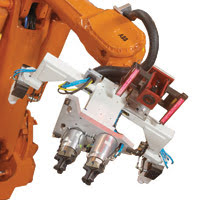Robot manufacturers are equipping their manipulators with 3-D vision to help them react to the variable positioning of workpieces. Instead of investing in jigs and rigs to position the component accurately, designers are using 3-D vision, which enables the robot to see where it really is and automatically applies an offset to the robot’s dynamic control program. ABB’s vision-guided robotics system TrueView features an automated calibration system that is easy and quick to set up. As the robot approaches its task, it snaps an image and uses geometric pattern recognition to locate features within the target. The size of those features helps determine distance. Then the controller corrects the position and orientation of the end effector to accommodate the randomly presented workpieces. One application is automated engine assembly: Toyota, Ford, Honda, General Motors and Chrysler all use TrueView. Aerospace manufacturers use vision for parts identification and inspection, and for drilling and riveting.

ABB robots equipped with TrueView 3-D vision guidance carry camera and lighting to locate the target and navigate the tooling accordingly.
Laser techniques are another way to approach 3-D machine vision. A laser line projected on a surface reveals its profile and alignment, and laser triangulation can achieve 0.01-mm resolution. Point clouds are another technique: The distortion of a regular grid of laser spots allows calculation of the shape of the surface. Paul Wilson of Scorpion Vision explained that 3-D vision does all of the following: replaces contact probes to measure the size and shape of automotive components, measures the wafer block to be sliced in the production of solar panels and calculates the best way to slice cheese from a large block to minimize waste. A close examination of a bakery cake followed by accurate 3-D modelling provides a template that a robot can follow when applying icing. This allows it to pipe the words and decorations on the undulating surface of the cake without gouging holes in it. Scorpion Vision software gives multiprocessor support of 3-D machine vision and requires no programming skills.
MultiPix Imaging supplies Z Laser products for 3-D profiling. Laser diode modules produce low-divergence beams, and optical accessories transform the collimated beam into a line, matrix or dot grid. Automation Technology GmbH makes the C3 family of laser scanning cameras with onboard field-programmable gate array processing to work out the parameters relevant to the application. This slimmed-down data transmits quickly to a PC for more detailed processing. This combines high spatial resolution with fast measurement for applications including adhesive bead and ball grid array inspection in microelectronics, and the inspection of tyres, rubber seals and welded seams in the automotive sector. The Spanish company AqSense has developed shape-processing software for 3-D pattern matching and difference imaging. The Match 3D tool is now incorporated into Stemmer’s Common Vision Blox software. The algorithms use light stripe peak detection to capture and compare the 3-D shape of components for gauging and quality control.
More suppliers are entering the 3-D image processing market, expanding the capabilities and applications potential.